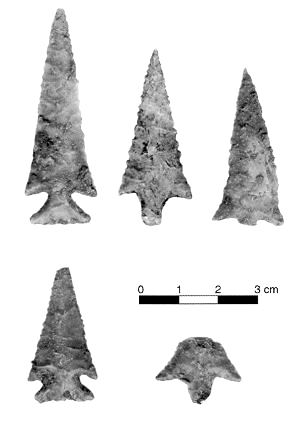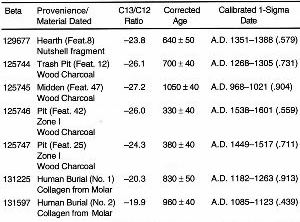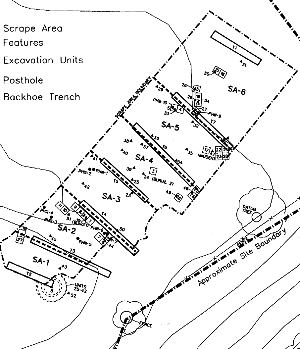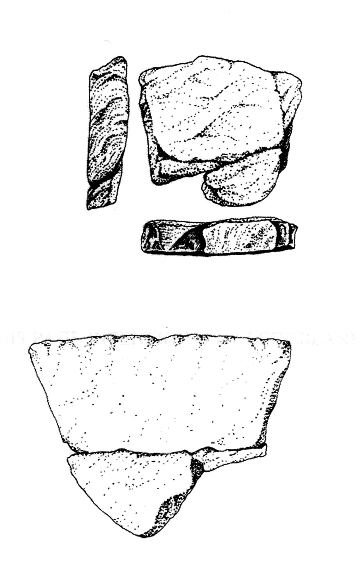Oxbow Site
The Oxbow site (41FB255) takes its name from its location adjacent to an oxbow lake in Ft. Bend County. During the late 1990’s the site was the scene of extensive excavations which led to the retrieval of important archeological data relevant to the prehistoric settlement of the Inner Gulf Coastal Plain of Texas.
Geologists tell us that around 3,000 years ago the lake near the Oxbow site was an active channel of the ancestral Brazos River, but by 1,000 to 1,500 years ago the river had changed course, leaving the river’s abandoned meander belt to become a curving lake that filled up during high and slowly silted in. This time corresponds with the earliest occupations at the site during the Early Ceramic archeological period.
The earliest visits to the site are represented by dart points, adzes, axes, and gouges found across the site. Such artifacts bear testimony to the felling and working of timber as well as hunting. Ceramics typical of the period were also found. These items suggest the site was likely the scene of one or more small settlements or base camps. The size of the groups that resided there was probably in the range of 15 to 25 individuals, perhaps representing one or more extended families.
The lake and the land surrounding it would have afforded these and later inhabitants an array of nutritious plants and animal resources. Charred bulbs of wild garlic and numerous hardwood nutshells were found at the site, and the large faunal assemblage, while dominated by deer (and possibly antelope) included bison, smaller mammals, birds, reptiles and fish. While some of the species found at the site were migratory, most were not, and thus the location may well have been attractive to the native peoples year round.
Radiocarbon dating of plants and animals at the site tell us it was utilized as late as A.D. 1600. However, it is the occupations that occurred between about A.D. 1100 and A.D. 1250 that are the most important, as they include two human burials. Both individuals were buried flexed (knees bent), with Burial 1 flexed on left side and Burial 2 tightly flexed on the right side. The heads of both were oriented to the south. The orientation of the head to toward the south and the degree of flexure follow consistent patterns among Texas coastal burial sites.
Burial 1 was that of a young man approximately 17 to 18 years of age. He was tall for a Native American, with a stature estimated to be 5’7”. Although less than 20 years of age at the time of his death, he suffered from severe dental disease, and had also experienced an earlier fracture to the back of the right leg from a blow or fall that had healed.
The most fascinating and unusual aspect of the young man's burial is that five arrow points were found within his chest and abdomen area, doubtless the cause of his death.The arrow points are of the types Scallorn, Perdiz and Bonham. The presence of three different types of arrow points embedded within the body in this burial at the Oxbow site is the only such instance known in Texas. The co-occurrence of the types Scallorn and Perdiz is surprising, because these distinctive types are considered time markers for successive phases of the late Prehistoric period. Using the classification scheme originally defined in central Texas, the Scallorn type is a marker for the Austin phase (roughly A.D. 800-1300), while the Perdiz type is a hallmark of the Toyah phase (A.D. 1300-1600 or somewhat later). The young man's death was obviously a moment in time when these types were both in use.
The second burial at the Oxbow site was that of a woman estimated to be at least 30 years old at the time of death. She stood about 5’4” in height. No apparent cause of death could be discerned. Degenerative arthritis was evident in the jaw, and her teeth were severely worn.
Samples of rib bones from Burials 1 and 2 were submitted for mitochondrial DNA analysis. The DNA was prepared from small fragments of bone in order to preserve as much of the remains as possible. Mitochondrial DNA is transmitted exclusively through the females. The analysis showed a fairly strong indication that the two individuals were related, though the degree of the relationship (mother-son, grandmother-grandson-aunt nephew etc.) could not be determined. Nonetheless, this finding shows that the two individuals were kinfolk, which is not surprising. Cross-culturally across the world, historically known hunting and gathering peoples typically lived in extended family groups and often returned to the same locations. The analysis of DNA from the two burials at the Oxbow site is the first instance of the use of this valuable technique on prehistoric human skeletal remains in Texas.
Stable isotope evidence obtained from small samples of bone from both burials indicates that the diets of the two individuals did not include either maize or shellfish. This suggests that they were inland coastal hunter and gatherers rather than sedentary peoples such as the Caddo, or coastal dwellers like the Karankawa.
The analysis of the archeological deposits at the Oxbow site betokens regularly repeated intermittent occupations that occurred between roughly A.D. 900 and A.D. 1600. That at least some of these visits were made by the same group is indicated by the DNA analysis. These visits to the site were probably part of an annual cycle by inland coastal plain hunter gatherers intent on exploiting specific seasonally available resources (such as nuts which ripen in the fall). Researchers believe that human populations across much of North America reached all time highs during the Late Prehistoric period. Thus it is not surprising that the group who frequented the Oxbow site came in contact with other groups competing for the same territory, a circumstance that resulted in conflict as each group vied for the control of the area.
Contributed by Robert Rogers, archeologist, PBS&J.
Sources
Rogers, Robert
2000 Excavations at Site 41FB255. Current Archeology in Texas 2(1): 16-17.
Rogers, Robert, Linda Wootan-Ellis, and Gary Rutenberg
2000 Archeological Data Recovery Excavation at Site 41FB255, Fort Bend County, Texas. PBSJ 440079, Austin. Prepared for the Department of the Army (Galveston District).

|
The presence of three different types of arrow points embedded within the body in this burial at the Oxbow site is the only such instance known in Texas. The co-occurrence of the types Scallorn and Perdiz is surprising, because these distinctive types are considered time markers for successive phases of the late Prehistoric period.
|

|


